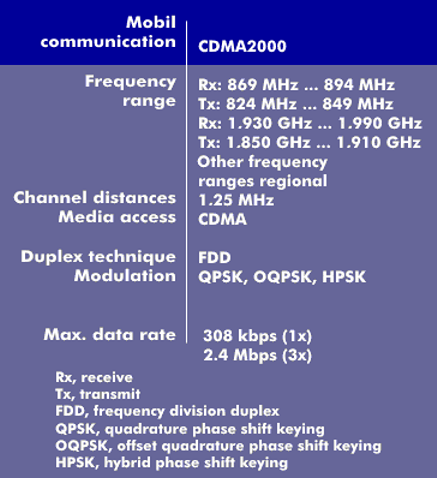CDMA2000
CDMA2000 belongs to IMT-2000 of3GPP, which realizes the transition from the 2nd generation mobile radio technologies to those of the 3rd generation. 3GPP recognizes three substandards for the migration of CDMA2000 into existing mobile networks according to IS-95: CDMA2000 1xRTT, CDMA2000 1xEV- DO and CDMA2000 1xEV- DV.
These three methods differ in terms of data and voice optimization and have different transmission speeds. In terms of transmission, CDMA2000 uses multiple carriers, each with a bandwidth of 1.25 MHz. Up to three carrier frequencies can be used (CDMA2000 3x). The 1.25 MHz wide carrier bands are spaced 1.5 MHz apart, creating a guard band between the individual frequency bands.
CDMA2000 1xRTT (Single Carrier Radio Transmission Technology): 1xRTT operates with one carrier frequency and corresponds to 2.5 generation ( 2.5G) with data packet switching. With a bandwidth of 1.25 MHz, the chip rate is 1.2288 MChips/s. With a smallest spreading code of 4 (4 chips/bit), a data rate of 307.2 kbit/s is achieved.
CDMA2000 1xEV-DO (Evolution Data Optimized): This substandard, which also operates with only one carrier frequency, uses the carrier band exclusively for data transmission, which is the reason for the higher data rate. With this method and quadrature amplitude modulation (16QAM), the data rates are a maximum of 2.45 Mbit/s in the downlink and 153.6 kbit/s in the uplink. 1xEV-DO is used in Evolution Data Optimized( EVDO) for mobile access to the Internet. CDMA2000 with its 1xEV-DO extension is used in North and South America.
CDMA2000 1xEV-DV (Evolution Data and Voice): In contrast to 1xEV-DO, data and voice are transmitted in one frequency band in this substandard.

